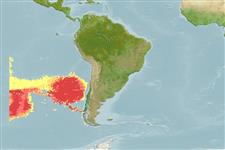Environment: milieu / climate zone / depth range / distribution range
Ecologia
marinhas batipelágico. Deep-water
Southeast Pacific: Chile.
Tamanho / Peso / Idade
Maturity: Lm ? range ? - ? cm
Ciclo de vida ou comportamento de acasalamento
Maturities | Reprodução | Spawnings | Egg(s) | Fecundities | Larvas
Pequeño, G., 1989. Peces de Chile. Lista sistematica revisada y comentada. Rev. Biol. Mar., Valparaiso 24(2):1-132. (Ref. 9068)
Status na Lista Vermelha da UICN (Ref. 130435)
Ameaça para os humanos
Harmless
Uso pelos humanos
Ferramentas
Relatórios especiais
Baixar XML
Fontes da internet
Estimates based on models
Preferred temperature (Ref.
123201): 1.4 - 1.8, mean 1.7 °C (based on 4414 cells).
Índice de diversidade filogenética (Ref.
82804): PD
50 = 0.5352 [Uniqueness, from 0.5 = low to 2.0 = high].
Bayesian length-weight: a=0.01000 (0.00244 - 0.04107), b=3.04 (2.81 - 3.27), in cm total length, based on all LWR estimates for this body shape (Ref.
93245).
Nível Trófico (Ref.
69278): 4.2 ±0.7 se; based on size and trophs of closest relatives
Fishing Vulnerability (Ref.
59153): Low vulnerability (10 of 100).
